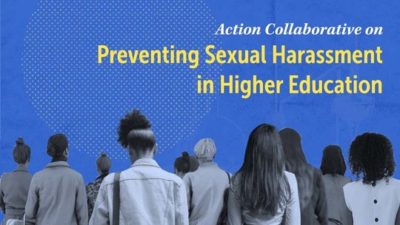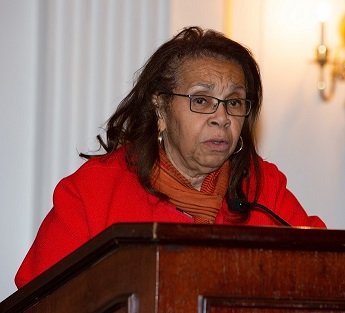A new wave of interventions and programs for reducing barriers to women in biomedical careers could be on the horizon because of an eye-opening report from the National Academies of Sciences, Engineering, and Medicine about the prevalence of sexual harassment in those fields.
 The National Academies and 43 universities, colleges, and research institutions have now formed the Action Collaborative on Preventing Sexual Harassment in Higher Education, which will discuss and promote evidence-based strategies to reduce sexual harassment. The group will soon hold its first meeting with all of its members.
The National Academies and 43 universities, colleges, and research institutions have now formed the Action Collaborative on Preventing Sexual Harassment in Higher Education, which will discuss and promote evidence-based strategies to reduce sexual harassment. The group will soon hold its first meeting with all of its members.
An important point in the report and direction for moving forward is acknowledging that gender harassment is a serious issue, says Elizabeth Hillman, a member of the committee that wrote the National Academies report and president of Mills College, which is a member of the Action Collaborative. Harassment could come in the form of remarks or other messages that are gender-based, hostile, or degrading. Such comments also create an environment that is conducive to other forms of sexual harassment, such as assault and coercion. “Once everybody realizes that [such remarks are] a big part of the problem, people have a chance to stop it through bystander intervention,” Hillman says. Indeed, the report recommends that workplaces offer bystander intervention training so people can respond when they see gender harassment.
The report also urges institutions to establish a clear process for handling sexual harassment allegations, like those they have for dealing with research misconduct, including opening an institutional investigation and reporting the findings to the National Institutes of Health (NIH) — a recommendation that “made all the sense” to Carol Greider, a professor of molecular biology and genetics at Johns Hopkins, 2006 Lasker Basic Medical Research Laureate, and winner of the 2009 Nobel Prize in Physiology or Medicine. Greider says that she has been meeting with the leadership at Johns Hopkins, which is a member of Action Collaborative, for the last six months about the report, and although everyone has good intentions, it is clear that it will take time to accomplish a real change.
Will new interventions catch on?
In 2008, the NIH started providing funding for 14 institutions to study obstacles to women in biomedical careers and to provide programs to reduce those obstacles. The investment was in response to a 2007 report by the National Academies that concluded that implicit bias and unsupportive institutional structures are the main reasons for the extreme underrepresentation of women in science faculty and leadership roles. Even though women have long been earning about half of the PhD degrees in the United States, they make up only 29% of assistant professors and 21% of full professors at the top-ranked research institutions in the country.
The institutions tested a range of interventions, including teaching faculty in STEMM (science, technology, engineering, math, and medicine) departments about implicit bias and how to keep implicit bias from affecting their behavior, as well as school-wide efforts to support women faculty and programs raising awareness about child leave and other flexible career policies.
The positive impacts of some of the new approaches have been widely published and discussed. Yet there is no evidence of broad uptake, says Janine Clayton, director of the Office of Research on Women’s Health at the NIH and co-chair of the working group that led the NIH’s investment in this research. Although some of the institutional changes live on — at least in some form — at the individual schools, they have not really caught on more widely.
“Why don’t we see the next cohort of women benefit from new programs?” Clayton asks. It could be, she adds, because institution-wide change is slow and institutions do not have funding for new programs. A National Academies study, funded by the NIH, the National Science Foundation (NSF), and the L’Oreal Foundation, will be published in spring 2020 to address this question.
The big question about interventions that try to reduce sexual harassment and promote women in science is will they be widely adopted?
Stimulating far-reaching change
So far, institutions in the United States have mostly tackled individual barriers to women in science, whether it’s implicit bias or the heavy load of family responsibilities that women tend to have.

Shirley Malcom, director of SEA Change, speaks at the AAAS Meeting in February about the program.
“We have got to stop looking at it one barrier at a time and look at the entirety of the institution,” says Shirley Malcom, director of the Stem Equity Achievement (SEA) Change Initiative at the American Association for the Advancement of Science (AAAS).
SEA Change, which launched last year and is funded by the Sloan Foundation and Heising-Simons Foundation, provides a framework for universities who want to assess how diverse and equitable their STEM departments are (or aren’t) in terms of gender as well as race and ethnicity. Institutions submit an in-depth assessment along with an action plan of how they plan to reduce the barriers they identified. Institutions are eligible for a bronze award (and later, if they demonstrate progress, a silver or gold award).
The inspiration for SEA Change is a similar award-based program that started in the United Kingdom in the early 2000s, the Athena Project and the Scientific Women’s Academic Network (SWAN) to advance women in science, and now the latter includes work in many other fields, such as arts and humanities. Australia, Ireland, and recently Canada have all developed their own versions of Athena SWAN. The program got a big boost in England in 2011 when its chief medical officer announced that institutions would not be eligible for National Institute for Health Research (NIHR) or Biomedical Research Centre funding unless they had a silver or gold award. “If [NIH and NSF] would say having a SEA Change award is a plus for an institution, it would incentivize them even more to go through this process,” Malcom says.

The team from Boston University that carried out the SEA Change process of self-assessment accepts their bronze award from Shirley Malcom (front right) and AAAS President Margaret Hamburg (back row, third from right) at the AAAS meeting in February. Joyce Wong (front row, center), who led the effort, says she was thrilled that so much of the team, including a provost, dean, and chair, was present to accept the award because it demonstrated the university’s commitment to change.
In the first pilot phase of SEA Change, three US institutions went through the process and were given bronze awards at the AAAS meeting in February: Boston University, the University of California, Davis, and the University of Massachusetts, Lowell. “I’m really hopeful because we have this action plan that we can rally around; it is grounded in data with a concrete assessment,” says Joyce Wong, a biomedical engineering and materials science and engineering professor at Boston University who led the university’s SEA Change application. “But it can’t just be [these three universities]. I’m excited to see other institutions come on board, and for all institutional stakeholders to be involved in the process, and I’d be happy to help them. That’s the only way this is going to move forward.”
The action plans the schools submitted include commitments to expand bystander training to help ensure that voices of women, minority, and junior faculty are heard in department meetings; reduce the burden on women and minority faculty who tend to be asked to join many committees; help family members of new faculty find jobs; and improve lactation rooms.
The field of academic medicine in the United States has tried many interventions, and “we have seen some increases in women in these senior levels [tenured faculty, department chairs, and deans], but women have not advanced to these positions at the rate that would be expected,” says Jeanette Mladenovic, former executive vice president and provost at Oregon Health & Science University. A lot of credit for the progress that has been made, she adds, goes to the various offices for women that many institutions and professional societies have established over the last couple of decades, as well as the Association of American Medical Colleges (AAMC) and Executive Leadership in Academic Medicine (ELAM) program, to help connect and support women faculty.
However, not all medical schools have an office focused on supporting women, and they “may not be able to support the breadth of needs for women as they ascend the academic ladder and reach leadership,” Mladenovic says. As a result, she has created a national organization, the Center for Women in Academic Medicine and Science (CWAMS), with help from the Lasker Foundation and Macy Foundation, to fill those gaps by helping women in academic medical careers network and supporting women in university leadership positions.
“We’ve too often tried to change women to fit into a culture that was for many years a totally male culture,” Mladenovic says. Now, she adds, it is time to change the culture to fit both women and men, so that everyone can thrive.
By Carina Storrs
Read May’s newsletter, “The Leaking Pipeline,” to learn more about the obstacles women scientists face in their careers.
